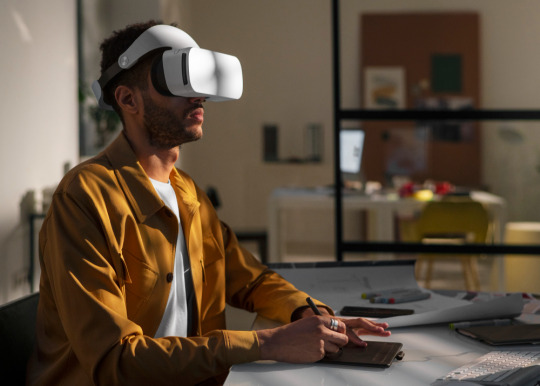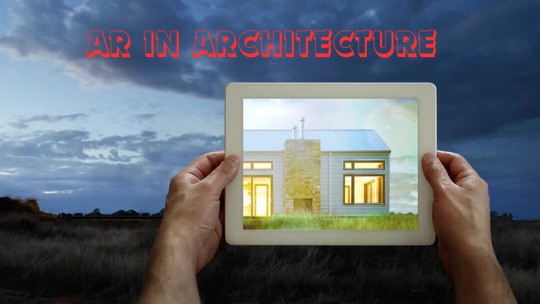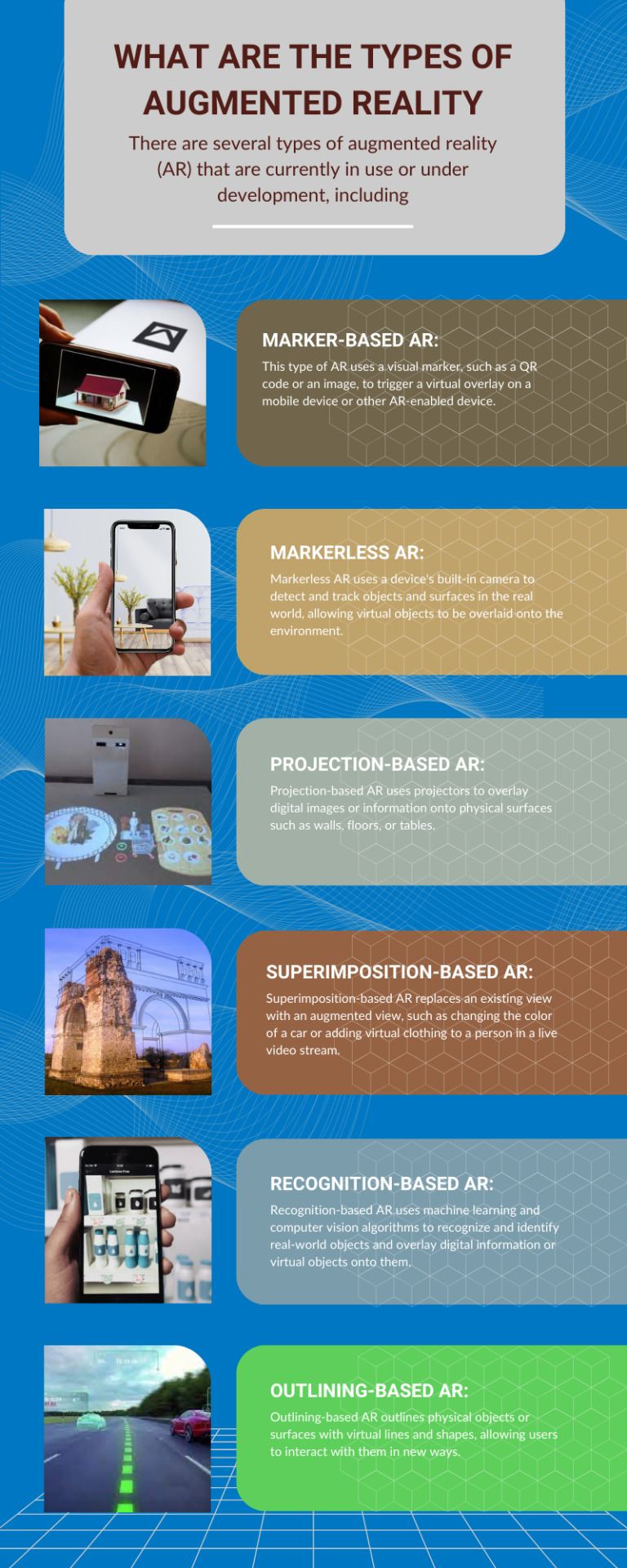#ardevelopment
Explore tagged Tumblr posts
Text
Vision Pro App Development: Step Into the Future of Spatial Computing
Apple’s latest innovation, the Vision Pro, has opened up new frontiers for immersive digital experiences and it’s reshaping the app development landscape.
Whether you're in retail, healthcare, or entertainment, Vision Pro App Development unlocks new ways to engage users through interactive 3D environments and spatial UX.
💡 In this blog, you’ll explore: ✅ Why Vision Pro is a game-changer for app developers ✅ Business use cases to inspire your next big idea ✅ Tech stack and design principles tailored for VisionOS ✅ Why it’s the perfect time to invest in Vision Pro App Development
This blog is a must-read for CTOs, innovation heads, and tech-driven entrepreneurs looking to lead in the spatial era.
#VisionProAppDevelopment#SpatialComputing#VisionOS#AppleVisionPro#TechInnovation#ARDevelopment#FutureTech#ImmersiveApps#CTOInsights#KodyTechnolab
0 notes
Text
5 Key UX/UI Principles for Designing Augmented Reality (AR) Applications
Introduction
Augmented Reality (AR) is changing how we interact with the digital world, seamlessly blending virtual elements with our surroundings. A well-designed AR application provides a smooth, intuitive experience that enhances usability and engagement. However, designing AR apps comes with unique challenges, such as real-world adaptation and spatial awareness. Whether you are working with an android game development company or creating enterprise AR solutions, focusing on UX/UI principles will ensure a better experience. Let’s explore five key guidelines that can help make AR applications more effective and user-friendly.
1. Seamless Integration with the Real World
For an AR experience to feel natural, virtual objects must merge effortlessly into the user's environment. If AR elements appear misplaced or unrealistic, it can disrupt the experience and make interactions awkward.
Best Practices:
Use real-world lighting and shadows to make AR objects blend naturally.
Apply object occlusion, ensuring AR objects behave realistically (e.g., an AR object placed behind a real object should be partially hidden).
Optimize spatial tracking to keep AR elements stable and responsive as users move.
Keep the interface uncluttered; too many digital elements can overwhelm users and reduce engagement.
A smooth, real-world integration makes AR more immersive and enjoyable.
2. Intuitive and Simple Interactions
A great AR application should feel natural and easy to use. Users should be able to interact with it effortlessly, without needing a steep learning curve. Since AR is different from traditional apps, designers should move beyond standard buttons and menus.
Best Practices:
Use familiar touch and gesture controls (tap, swipe, pinch) for natural interactions.
Provide real-time visual and haptic feedback to confirm actions.
Avoid complicated multi-step gestures that may frustrate users.
Offer guided onboarding experiences to help users understand features quickly.
If you're developing AR applications with an android game development company India, prioritizing ease of use will improve user engagement.
3. Minimalistic & Adaptive UI Design
Unlike traditional apps, AR applications need a UI that is lightweight and non-intrusive. Cluttered interfaces can distract users and take away from the immersive experience.
Best Practices:
Display only essential UI elements and use gestures or pop-ups for additional options.
Use semi-transparent overlays to avoid obstructing the real-world view.
Position UI elements where they are easily accessible without being intrusive.
Make UI elements adaptive, adjusting dynamically based on the user’s environment.
Collaborating with the best android game developer company ensures a clean, well-designed interface that enhances focus without being overwhelming.
4. Enhanced Spatial Awareness & Depth Perception
AR relies on accurate spatial positioning, which means users need to perceive depth and space correctly. Poorly defined depth perception can make objects appear unnatural or difficult to interact with.
Best Practices:
Use depth cues such as shading, object scaling, and motion effects to create realistic distances.
Ensure AR elements adjust dynamically based on user movement.
Allow users to manually move and resize AR objects for better control.
Layer objects properly so that they appear in a natural hierarchy within the scene.
Working with an android game development company USA can help fine-tune depth perception for a more immersive AR experience.
5. Accessibility & User Comfort
AR applications should be inclusive, ensuring they work for people with different abilities and preferences. A poorly designed AR experience can cause motion sickness, eye strain, or discomfort.
Best Practices:
Reduce fast or erratic movements to prevent dizziness.
Offer alternative controls such as voice commands for users with limited mobility.
Design UI elements with high contrast and clear text for better visibility in various lighting conditions.
Allow users to adjust settings, including brightness and interaction sensitivity, for personal comfort.
A user-first approach ensures that more people can enjoy AR applications, whether developed by an android game development company associative or a large-scale enterprise.
Conclusion
Designing AR applications is about creating seamless, natural, and enjoyable experiences that feel like an extension of the real world. Whether you’re working with an android game development company or a startup experimenting with AR, focusing on these UX/UI principles will ensure a smoother and more engaging user experience. By prioritizing real-world integration, intuitive usability, minimalistic UI, spatial awareness, and accessibility, designers can develop AR applications that truly enhance digital interactions.
A well-designed AR experience doesn’t just augment reality it transforms how we interact with the world.
#AugmentedReality#ARDesign#UXUI#ARDevelopment#UserExperience#UIDesign#AndroidGameDevelopment#ARApplications#ImmersiveTech#GameDevelopment#MobileUX#SpatialComputing#XRDesign#TechInnovation#HumanCenteredDesign#ARGaming
0 notes
Text
Metaverse App Design: A Strategic Blueprint for Business Leaders

Unlock the potential of Metaverse App Design with this strategic guide tailored for business leaders. Explore key design principles, user engagement strategies, and the latest trends to build immersive digital experiences. Stay ahead in the virtual world by creating apps that drive innovation, enhance brand presence, and maximize business growth in the Metaverse era.
0 notes
Text
0 notes
Text
VR App Development Simplified: Trimorphic Technologies’ Solutions
As the demand for virtual reality (VR) experiences continues to rise across industries, businesses are seeking ways to integrate immersive technologies into their products and services. Trimorphic Technologies stands out as a leader in simplifying VR app development to help clients create stunning, interactive solutions that are tailored to their specific needs.

The Power of VR: Transforming Industries
Trimorphic Technologies understands the potential of VR in various sectors such as gaming, education, healthcare, and real estate. By leveraging cutting-edge technologies, they create VR applications that offer rich, immersive experiences to users. Whether you're developing training simulations, virtual tours, or educational apps, Trimorphic Technologies is the trusted partner to bring your VR vision to life.
Why Choose Trimorphic Technologies for VR App Development?
Seamless Integration: With a strong understanding of AR/VR development, Trimorphic Technologies ensures that your VR application integrates smoothly into your existing platforms, providing an efficient and user-friendly experience.
Custom Solutions: The team specializes in creating custom VR apps tailored to meet the unique needs of your business. From 360-degree video apps to real-time VR collaboration tools, they offer a range of solutions to enhance your brand.
Cutting-Edge Technology: Powered by the latest in VR headsets, motion capture, and interactive technologies, Trimorphic Technologies ensures that every VR app is optimized for the best performance and engagement.
Enhanced User Experience: Focused on user-centric design, Trimorphic Technologies ensures that every VR app they build delivers a seamless and intuitive experience, boosting engagement and satisfaction.

Notable Projects by Trimorphic Technologies
One of the standout projects Trimorphic Technologies has worked on is a VR training simulation for a leading manufacturing company. This VR application helped train employees in a virtual environment, improving productivity and reducing training costs. Another project involved creating a virtual property tour app for a real estate company, providing potential buyers with an interactive, 3D walkthrough experience.

OEM Partnerships for Greater Impact
Through its OEM partnerships, Trimorphic Technologies has also developed VR solutions for industry leaders, ensuring high-quality products with unmatched performance. This collaboration enables them to deliver industry-standard VR apps across different devices and platforms.
To learn more about how Trimorphic Technologies can revolutionize your business with innovative VR app solutions, visit our website.
#VirtualReality#VRAppDevelopment#CustomVRApps#ImmersiveExperience#AugmentedReality#ARDevelopment#360VideoApps#VirtualTraining#TrainingSimulations#InteractiveTech#UserExperienceDesign#RealEstateApps#VRforEducation#TechnologySolutions#CustomApps#AppDevelopment#VirtualTours#TechInnovation#XRSolutions#MobileAppDevelopment#FutureofTechnology#Trimorphictechnologies
0 notes
Text
We made it happen! The whole KeMor team did an outstanding job at this year's Collision Conference. I am thrilled to introduce our incredible team:
- Production Designer: Masaaba Mwambu - Interdisciplinary Designer & Multimedia Artist: Marko Cigljarev - Software Developer: Denzel Edwards - Augmented Reality Developer: Jeannine Charles - Music Artist: Kiyoshi Shelton - Mental Health Lived Experience Expert: Kedan Edwards Pierre - Co-founder and Partner in Crime: Keda Edwards Pierre
A heartfelt thank you to each one of you for your exceptional work and dedication. Together, we've created something truly remarkable.
#KeMorTeam#CollisionConference2024#Innovation#MentalHealth#TechForGood#ARDevelopment#CreativeDesign#TeamSuccess#Gratitude#collisionconf#meditation#mindfulness
1 note
·
View note
Text

Looking for an edge in the gaming industry? 🕹️ Our AR development services deliver engaging and innovative experiences.
0 notes
Text

0 notes
Text
Augmented Reality | A Comprehensive Examination of the Market Trends, Regulatory Landscape, and Technological Innovations in the Sector
The global augmented reality market size is expected to reach USD 597.54 billion by 2030, registering a CAGR of 39.8% from 2023 to 2030, according to a new report by Grand View Research, Inc. The market growth can be credited to the increasing adoption of augmented reality (AR) technology across several industry verticals, such as automotive, healthcare, education, construction, and logistics among others. The augmented reality interfaces enhance the work environment as well as optimize operational efficiency while offering significant benefits in terms of efficiency, productivity, and safety.

Augmented Reality Market Report Highlights
In terms of component, software segment is expected to register a CAGR of around 41.0% during the forecast period owing to the rising adoption of AR devices across various applications, including manufacturing, healthcare, education, retail & e-commerce, among others
In terms of display, smart glass segment is expected to register a notable growth rate of 49.1% by 2030 with the increasing adoption of smart glasses beyond personal uses of entertainment to industrial applications such as architectural planning, manufacturing processes, healthcare, and more
In terms of application, industrial & manufacturing segment accounted for the revenue share of around 24.0% in 2022 as AR finds important application in businesses to ensure efficient operations by keeping all processes operational, spotting anomalies, and reducing production downtime
Asia Pacific augmented reality industry is estimated to witness a significant CAGR from 2023 to 2030 with the rapid expansion of manufacturing, logistic & transportation, automotive, and gaming & entertainment industries, especially in Japan and China
For More Details or Sample Copy please visit link @: Augmented Reality Market Report
AR technology has been evolving continuously and getting more accessible and reliable in line with the advances in technology. Several market players are focused on introducing new and more innovative offerings to attract customers and gain a competitive edge in the industry. For instance, in 2023, Google LLC announced the launch of its latest Immersive Stream for XR service for its Google Cloud customers. This new offering is said to eliminate the need for any powerful hardware or a special application to immerse oneself in the augmented reality or 3D world. The users can simply scan a QR code or click a link to get into extended reality (XR).
The growth of augmented reality industry is being influenced by the aggressive adoption of AR technology solutions by various industry incumbents, especially in the wake of the COVID-19 outbreak. For instance, AR technology is being widely adopted across educational institutions to enhance the learning experience for students.
The market is also benefiting from the retail domain as AR provides an immersive experience to shoppers and helps them make informed buying decisions. In November 2022, Snap, Inc. partnered with Amazon.com, Inc. to initiate AR-enabled digital try-on styles for the brands and customers online. This fashion partnership is anticipated to create an AR shopping experience seamless.
AR technology is gaining massive traction in niche markets. Several mobile device vendors are introducing AR-compatible mobile devices. As such, the market for augmented reality is poised for significant growth during the forecast period as AR technology continues to evolve and more real-life use cases are introduced.
#AugmentedReality#AR#VirtualReality#MixedReality#XR#ImmersiveTechnology#ARApplications#ARDevelopment#ARKit#ARCore#AugmentedWorld#ARExperience#ARIndustry#ARMarket#ARInnovation#FutureTech#DigitalTransformation#TechTrends#InteractiveTechnology#ARContent
1 note
·
View note
Text
Apple Vision Pro: The Future Is Now
Apple’s spatial computing marvel isn’t just about sleek design — it's redefining how we interact with digital content across industries. From immersive entertainment to revolutionized healthcare, the Apple Vision Pro use cases are already making waves.
🔍 Top 10 real-world applications you can’t miss:
3D virtual workspace for professionals 💼
Interactive product demos for eCommerce 🛍️
Remote training & virtual classrooms 🎓
Immersive patient care in healthcare 🏥
AR travel planning & virtual tourism 🌍
Design visualization for architects 🏗️
Enhanced sports broadcasting & fan experience ⚽
Real-time language translation 🌐
Remote assistance & field service 👷♂️
Mental health & wellness experiences 🧘
Whether you're a startup, enterprise innovator, or a product visionary, this blog is your window into what’s next in XR.
#AppleVisionPro#SpatialComputing#MixedReality#AugmentedReality#TechInnovation#DigitalTransformation#AppleXR#VisionProApps#ARDevelopment#KodyTechnolab
0 notes
Text
Transforming the Architectural Industry: Augmented Reality's Impact on Design
The architectural industry is constantly evolving, driven by technological advancements that enhance the way architects and designers create and visualize structures. One such innovation that has revolutionized the field is augmented reality (AR). Augmented reality architecture, often referred to as architecture and real estate, is changing the way professionals design, present, and experience architectural projects. We will explore the impact of augmented reality in the architectural industry and how it is reshaping the design process.

Augmented Reality in Architecture: A Brief Overview
Augmented reality, or AR, is a technology that overlays digital information, images, or 3D models onto the real world, providing a composite view of the physical environment and digital content. In the architectural industry, AR is employed to enrich the design process and enhance client interactions. AR in architecture can be integrated into various stages, including concept design, development, and presentation, offering several benefits:
Visualization:
Augmented reality allows architects to visualize their designs at a 1:1 scale, making it easier to assess how a building or space fits into its surroundings.
Client Engagement:
Clients can have a more immersive experience by walking through a virtual representation of their future space, helping them better understand the design and make informed decisions.
Collaboration:
AR facilitates collaborative efforts by enabling architects, engineers, and other stakeholders to operate on the same project simultaneously, even if they are geographically dispersed.
Design Concept and Development
A. Site Analysis and Contextual Integration
Augmented reality in architecture begins with site analysis. By utilizing AR apps and devices, architects can superimpose digital overlays onto physical landscapes. This integration of site-specific data, such as topography and environmental conditions, aids in designing structures that harmonize with their surroundings. It also helps in optimizing aspects like building orientation for solar exposure and views.
B. Design Visualization
Design visualization is a fundamental phase in the architectural process. Augmented reality allows architects to project 3D models of their designs onto physical spaces, enabling them to walk through and experience the design before construction begins. This immersive experience assists architects in refining their designs and making necessary adjustments.
Presentation and Client Engagement
A. Immersive Presentations
When presenting architectural designs to clients, augmented reality architecture provides a more immersive and engaging experience. Instead of traditional 2D blueprints or static 3D models, clients can explore the proposed space in real-time. This not only enhances their understanding but also builds trust and confidence in the architect's vision.
B. Real-time Changes and Feedback
During presentations, clients can request real-time changes and modifications to the design. Augmented reality allows architects to make these adjustments on the spot, showcasing the immediate impact on the design. This interactivity fosters better communication and decision-making.
Construction and Collaboration
A. On-site Guidance
AR plays a significant role in the construction phase by providing on-site guidance for workers. Through AR headsets or mobile devices, construction teams can access design information, 3D models, and step-by-step instructions, reducing errors and ensuring that the building aligns with the architect's vision.
B. Remote Collaboration
In today's globalized world, architectural teams often work from different locations. Augmented reality in architecture allows remote collaboration, with team members virtually coming together in a shared augmented reality space. This real-time collaboration ensures that everyone involved is on the same page, leading to more efficient project management.
Augmented Reality in Real Estate
The application of augmented reality extends beyond the architectural design process and into the real estate industry. AR in Architecture & Real Estate is increasingly being used in marketing and selling properties. For example, prospective buyers can use AR apps to view the interior design of a property before purchasing, helping them make informed decisions.
Augmented Reality in Manufacturing
While AR is primarily associated with architectural design and real estate, it is worth mentioning its growing significance in manufacturing. Augmented reality in manufacturing enhances the design and production of architectural components, such as prefabricated materials. Manufacturers can use AR to optimize processes, improve quality control, and ensure that components fit perfectly into the architectural designs.
Conclusion
Augmented reality architecture is transforming the architectural industry, offering innovative solutions for design, presentation, construction, and even real estate. Architects are embracing AR to create more sustainable, context-aware, and user-centric designs. The immersive and interactive qualities of augmented reality not only streamline the design process but also enhance client engagement and collaboration among project stakeholders. As AR technology continues to advance, its role in the architectural industry is set to expand, further revolutionizing the way architects conceive and bring their designs to life.
0 notes
Text

What Are the Type Of Augmented Reality
The real-time integration of digital information with the environment of the user is known as augmented reality (AR). Users of augmented reality (AR) encounter a real-world environment with created perceptual information superimposed on top of it, as opposed to virtual reality (VR), which produces a completely artificial environment.
0 notes
Text
Technical Considerations When Developing Virtual Try-On (Augmented Reality) Using Unity

Augmented Reality (AR) enables the overlay of digital content on the physical world. This AR enables overlaying a digital product on top of a physical world, as one experiences in the Virtual Try-On. Unity, a powerful and versatile platform, is widely used for AR development due to its robust support for 3D rendering, scripting, and integration with AR frameworks like ARKit and ARCore. However, several technical elements should be considered when using Unity to ensure optimal performance and user experience.
Platform and Device Compatibility
At the outset, developers must identify the audience target platforms (iOS, Android, or both) for the solution. In cross-platform development, developers must consider variations in hardware capabilities (e.g., camera quality, processor speed, and sensors). To ensure seamless operations, the solution should be tested on multiple devices to identify and address device-specific issues.
Choosing the Right AR Framework
Unity supports popular AR development frameworks, including ARKit (iOS), ARCore (Android), and Vuforia (cross-platform). The framework choice depends on the application requirements, such as marker-based or marker-less AR, environmental tracking, or object detection. To optimise alignment with the project goal, the pros and cons of each framework should be evaluated and aligned with functionality and performance needs.
Optimizing Performance
AR applications can be resource-intensive, so performance optimisation should be integral to the development. Some points of consideration are efforts to minimise draw calls (rendering instructions sent from CPU to GPU), reducing the polygon count of 3D models, and optimising textures and shaders. Unity’s Profiler is a valuable tool for monitoring performance metrics and identifying development bottlenecks. Efficient memory management and a steady frame rate are critical for smooth AR experiences.
Spatial Tracking and Anchors
Robust spatial tracking is foundational for AR. Unity and AR frameworks, depending on the target platform, provide tools for motion tracking (Visual-Inertial Odometry—VIO, device position and orientation relative to the environment), environment detection (plane, scene, depth, point cloud), and anchor management.
User Interface and Experience
In AR applications, user interaction spans three dimensions: spatial positioning, viewpoint adjustments, and input methods like gestures, touch, and gaze tracking, necessitating intuitive interfaces. UI elements must adapt to real-world spatial contexts without overwhelming the user. Designing AR interactions that feel natural, such as gaze or gesture-based controls, enhances user engagement.
Testing and Debugging
Testing AR applications requires real-world scenarios to validate functionality. Unity’s Play Mode allows basic testing, but deploying to actual devices is essential for evaluating tracking, performance, and user interactions. Using tools like Unity Remote can streamline this process.
Compliance and App Store Guidelines
Finally, platform-specific development guidelines, regulatory guidelines and user privacy are essential, given that AR uses camera and location data. Addressing these early ensures smooth deployment.
By P-XR AG: Technical Considerations When Developing Virtual Try-On (Augmented Reality) Using Unity
0 notes
Text
Leading Metaverse Development Companies in the USA
Explore the forefront of the digital revolution with our comprehensive list of the top Metaverse development company in USA. Discover the pioneers shaping the future of virtual worlds, augmented reality, and immersive experiences.
Whether you're seeking expertise in virtual reality (VR), augmented reality (AR), blockchain technology, or 3D modeling, these companies are at the forefront of Metaverse development. Dive into the world of endless possibilities and connect with the experts who are redefining how we interact with digital spaces.

0 notes